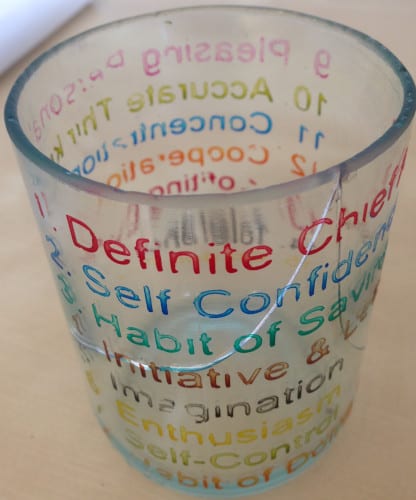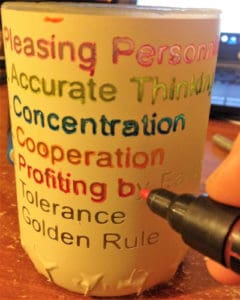
All paints, including permanent types like our water-based glass paints, may peel off with the stencil. This post will discuss solutions to prevent this or increase the likelihood of the paint staying in place!
Solution 1: Allow Paint to Dry for Several Weeks Before Removing Stencil
The paint peeling is rather annoying and I have been trying to test various drying times to find a solution with stencils.
Peeling the stencil right after applying the paint caused the paint to just smear or run. But allowing it to a few days causes the paint to bond to the stencil!
I think it may depend on the paint used, but I realized when our bakable water-based paint is left on with the stencil for several weeks, it seems to bond to the glass better. This prevents the paint from peeling but you still have to be cautious. I suggest peeling the stencil slowly and cutting it up in sections first with a razor blade. In the below photo, I first started to peel the stencil off 2 days after applying it and most of the parts came off. Then I waited about a month and most of the stencil came off without the paint peeling further.

(Please disregard the crack in the glass. I accidentally dropped it during this test.) Most parts where the paint didn’t peel off was because it dried for over a month.
The only downside is most folks probably won’t want to wait weeks for paint to bond better. I plan to do another test by lightly baking the paint (only hot enough so that the stencil doesn’t burn) and waiting a day. I think that may do the job as well so folks don’t have to wait weeks for a good paint-to-glass bond. Remember, this is only for the bakeable water based paint- we had a lacquer based paint which wouldn’t work for baking.
Solution 2: Etching the Glass First
As you may know, there are various ways to etch the stencil design into the glass. You can use rotary engraving, etching cream, or sandblasting.
Regardless of the method used, this abrades the glass surface so that it is rougher. The roughened glass surface allows the paint to bind better than a smooth surface. This can reduce the possibility of the paint lifting with the stencil because the bond on the glass will be increased.
Solution 3: Engrave Glass Below Stencil Surface First with Sandblasting
To go along with the previous solution, this discusses the best etching method for preventing paint peeling and how to do it.
To completely stop the paint from peeling with the stencil, you should use the sandblast etching process. By sandblasting the stencil, you can abrade away the glass below the surface. After the stencil is sandblasted, be sure to blow off all the abrasive and dust, then wipe with a wet lint free cloth. Once dry, you can paint the stencil. The paint will be below the stencil and prevent it from peeling with it.

In this example, the stencil font was a bit too small to prevent paint overlap. However, our permanent glass paint markers reduced overlap.
Solution 4: Try Not to Overlap Paint Onto Stencil Surface
This solution is common sense but is another way to reduce the possibility of the paint pulling up with the stencil without having to engrave the glass first.
There will always be some paint overlapping when air-brushing it on, but you can aim to reduce the overspray. Using fine paint brushes or paint markers can help you apply it within the stencil without much overlap. However, this solution takes more time and attention to detail so it can be frustrating. It almost defeats the purpose of using a stencil and placing a printed paper outline of the design behind the glass may be a better way to go.
Overall
Overall, I was most impressed to find that you can prevent paint from peeling simply by waiting several weeks for the paint to air dry before removing the stencil. If the painted stencil has intricate details or fine text, it still may be prone to peeling slightly.
But in the end, sandblasting the glass first is the best way to prevent the glass paint from peeling if you are okay with an etched colored glass look.
We Want to Hear From You
Please leave us a comment below. What solution has worked best for you when applying glass paint with stencils? Do you have a great solution to add?
Share this on social media or email by clicking below!




